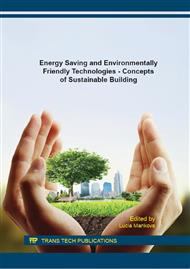p.779
p.786
p.795
p.803
p.811
p.821
p.829
p.836
p.845
Effect of Vegetation on Wind-Comfort
Abstract:
Air flow pattern in urban environment are radically influenced by the sophisticated topography of buildings. Although in general the wind velocity is less than that in rural areas there are many critical points where the air movement accelerates. Such phenomenon can be observed in narrow streets, around the corners and below arcades.Vegetation can not only decrease the wind velocity but accelerate it. Trees can redirect air flow downward, whilst shrubs do upward. Around the corners of buildings high wind velocity and turbulence can develop which itself may lead to discomfort, in case of gust even the chance of accidents cannot be excluded. Together with low air temperature the wind-chill index may result in thermal discomfort.From the point of view of pedestrians the air flow up to the 2 meter height is to be investigated. The question is how the whirling air flow around the building corners can be tempered by vegetation in this band. The height of shrubs may be estimated as 1 meter while the canopy of trees hinders the air flow from about 3 meter height. Different combinations of shrubs and trees may contribute to wind discomfort as well as prevent it. In this paper the suitable arrangement of vegetation is analysed in function of street layout and wind direction.
Info:
Periodical:
Pages:
811-818
Citation:
Online since:
January 2016
Authors:
Keywords:
Price:
Сopyright:
© 2016 Trans Tech Publications Ltd. All Rights Reserved
Share:
Citation:


